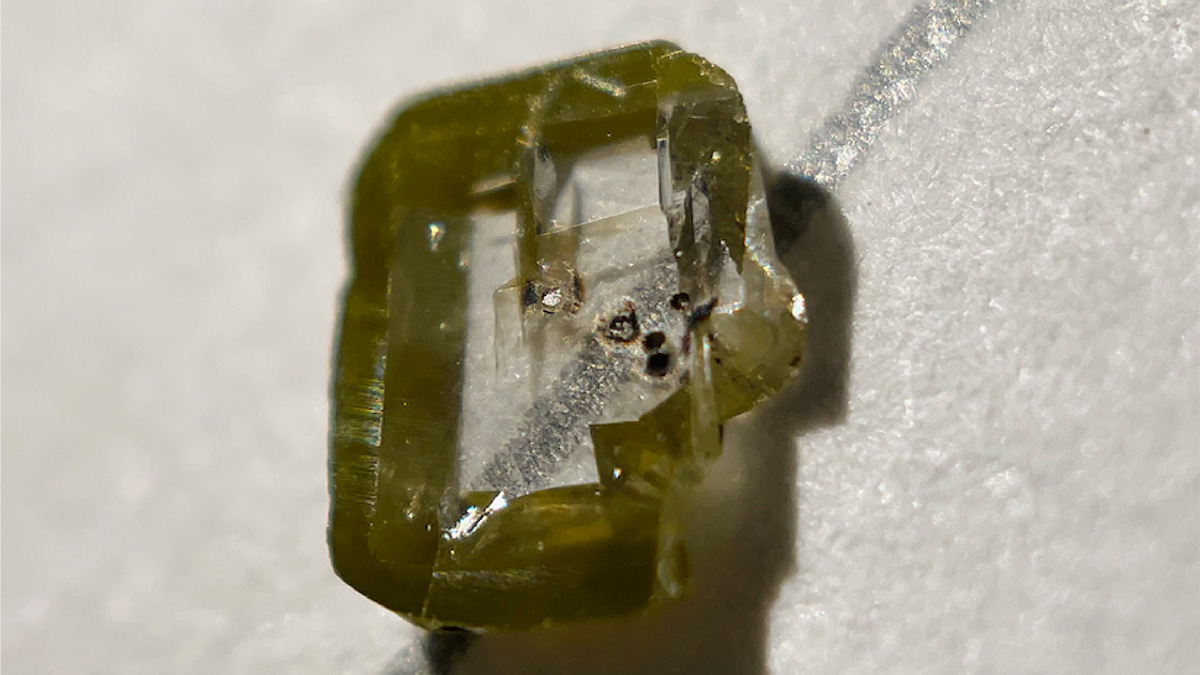For decades, geologists have thought that Earth’s deep mantle is largely composed of silicate minerals with a perovskite crystal structure. But mineralogical evidence has been very difficult to obtain.
The elusive calcium and magnesium silicate perovskites, although synthesized in the laboratory decades ago, are not stable below pressures of 20 gigapascals. That makes them nearly impossible to find in the lithosphere and rare even in the upper mantle. The high pressure of the lower mantle starts about 660 kilometers underground and extends about 2,000 kilometers below that.
The inclusion reduces the diamond’s value to a jeweler but for a geoscientist makes it priceless.
Now, in a new report published in Science, researchers identified the presence of a natural calcium silicate (CaSiO3) perovskite from the deep mantle. Found in the inclusion of a deep-Earth diamond sourced from Botswana, the perovskite was officially confirmed as a new mineral by the International Mineralogical Association and called davemaoite. The mineral was named after geologist Ho-Kwang “Dave” Mao, in honor of his prolific contributions to deep-mantle geophysics and petrology. Mao, who was himself not involved in the research, responded by remarking on the rarity of the diamond: “The diamond not only preserved a high-pressure mineral inclusion but also preserved the ‘pressure’ itself,” he said in an email. “The inclusion that normally spoils the clarity of an otherwise perfect gem diamond here makes the diamond uniquely invaluable with the scientific message it carries.”
As Mao indicates, the inclusion reduces the diamond’s value to a jeweler but for a geoscientist makes it priceless. Oliver Tschauner of the University of Nevada, Las Vegas, and his team were not fully aware of the diamond’s scientific value until they analyzed it with micro X-ray fluorescence and diffraction techniques as part of a larger analysis of inclusions in deep-Earth diamonds. “The discovery was quite a surprise—we did not expect that this mineral can be conserved, even in a diamond,” said Tschauner in an email.
Unearthing Secrets of the Lower Mantle
The discovery helps reveal the composition of the lower mantle, where davemaoite, along with bridgmanite and ferropericlase, is a major component, making up about 5%–7%, according to Tschauner. The newly identified mineral also plays a role in regulating the heat budget of our planet. During the team’s investigation, structural and chemical analysis showed davemaoite can host various elements (such as potassium, thorium, and uranium) whose isotopes generate heat in the lower mantle but are not stable in the upper mantle. These heat fluctuations help drive processes such as plate tectonics.
Davemaoite also tells us more about how diamonds form at depth, Tschauner explained: “The identification of davemaoite in a diamond proves that diamond formation (and the recycling of carbon in the mantle) extends to that depth. This had been proposed by some scientists but here is the evidence.”
Tschauner said the discovery is an encouraging sign that more deep mantle minerals are waiting to be found. “Already, a few have been discovered, including breyite, jeffbenite and ringwoodite. Diamonds from the deep mantle are quite uncommon but it seems only a matter of time until we hit an inclusion of bridgmanite,” he added.
—Clarissa Wright (@ClarissaWrights), Science Writer
This news article is included in our ENGAGE resource for educators seeking science news for their classroom lessons. Browse all ENGAGE articles, and share with your fellow educators how you integrated the article into an activity in the comments section below.


